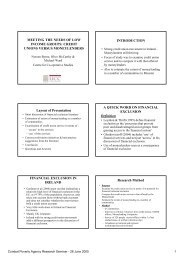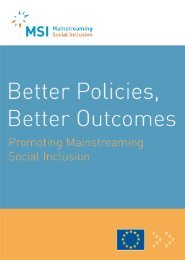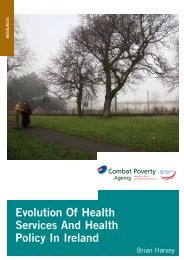Poverty Impact Assessment in the National Development Plan (2006)
Poverty Impact Assessment in the National Development Plan (2006)
Poverty Impact Assessment in the National Development Plan (2006)
You also want an ePaper? Increase the reach of your titles
YUMPU automatically turns print PDFs into web optimized ePapers that Google loves.
POVERTY IMPACTASSESSMENT INTHE NATIONALDEVELOPMENT PLAN<strong>2006</strong>Issues and LessonsKATHY WALSHSUMMARYThis document highlights <strong>the</strong> key issues that have arisenfrom <strong>the</strong> experiences and practices of apply<strong>in</strong>g a newpoverty proof<strong>in</strong>g 1 approach to <strong>the</strong> 2000-<strong>2006</strong> <strong>National</strong><strong>Development</strong> <strong>Plan</strong> (NDP). It identifies a number of keylessons emerg<strong>in</strong>g from this experience which are relevant to: Enhanc<strong>in</strong>g <strong>the</strong> poverty impact assessment approach <strong>in</strong> general Embedd<strong>in</strong>g <strong>the</strong> poverty impact assessment approach <strong>in</strong> <strong>the</strong> new <strong>National</strong> <strong>Development</strong> <strong>Plan</strong> 2007-2013 The importance of <strong>the</strong> role of monitor<strong>in</strong>g and evaluation <strong>in</strong> relation to poverty impact assessment The extent and nature of resources that would be required to adequately apply a poverty impactassessment approach to <strong>the</strong> new <strong>National</strong> <strong>Development</strong> <strong>Plan</strong>.1 Now poverty impact assessment2
POVERTY IMPACTASSESSMENT IN THENATIONAL DEVELOPMENT PLAN<strong>Poverty</strong> Proof<strong>in</strong>g<strong>Poverty</strong> proof<strong>in</strong>g of policies has been <strong>the</strong> pr<strong>in</strong>cipal <strong>in</strong>strument for ma<strong>in</strong>stream<strong>in</strong>g social<strong>in</strong>clusion at central Government level <strong>in</strong> Ireland s<strong>in</strong>ce late-1998. Policies andprogrammes are assessed at design and review stage to identify <strong>the</strong>ir impact on peopleexperienc<strong>in</strong>g poverty so that this can be given proper consideration and any necessaryameliorative measures taken. In February 2000, <strong>the</strong> <strong>National</strong> Economic and SocialCouncil (NESC) reviewed <strong>the</strong> poverty proof<strong>in</strong>g process and found that, while it has hadan important impact <strong>in</strong> terms of sensitis<strong>in</strong>g policy makers to poverty issues, a numberof deficiencies need to be addressed to improve its effectiveness. These <strong>in</strong>clude <strong>the</strong> needfor relevant statistical data to underp<strong>in</strong> <strong>the</strong> proof<strong>in</strong>g exercise and greater <strong>in</strong>formation,tra<strong>in</strong><strong>in</strong>g and expert support for officials. Accord<strong>in</strong>gly, <strong>the</strong> Office for Social Inclusion (OSI)was mandated to develop a more effective poverty proof<strong>in</strong>g process, and to ensure thatit is appropriately operationalised <strong>in</strong> all relevant Government departments.<strong>Poverty</strong> <strong>Impact</strong> <strong>Assessment</strong>The Office for Social Inclusion (OSI), draw<strong>in</strong>g largely on this NESC review and on afur<strong>the</strong>r process of consultation, has now developed a new set of guidel<strong>in</strong>es for <strong>Poverty</strong><strong>Impact</strong> <strong>Assessment</strong>. The change of name seeks to make it clear that <strong>the</strong> assessment ofimpacts of policies on poverty should form an <strong>in</strong>herent part of <strong>the</strong> policy mak<strong>in</strong>gprocess, ra<strong>the</strong>r than an exercise which takes place after a policy has been adopted. Thenew guidel<strong>in</strong>es are be<strong>in</strong>g <strong>in</strong>troduced <strong>in</strong>itially <strong>in</strong> Government departments and can bemodified <strong>in</strong> <strong>the</strong> light of experience of <strong>the</strong>ir use <strong>in</strong> this area. It is <strong>the</strong>n <strong>in</strong>tended that <strong>the</strong>guidel<strong>in</strong>es will be <strong>in</strong>troduced <strong>in</strong> <strong>the</strong> wider public service.<strong>Poverty</strong> Proof<strong>in</strong>g is particularly important <strong>in</strong> <strong>the</strong> context of <strong>the</strong> NDP because:1. The NDP is <strong>the</strong> ma<strong>in</strong> structure through whichbillions of private, public and EU funds are<strong>in</strong>vested <strong>in</strong>to public policies, projects, andprogrammes <strong>in</strong> Ireland. It makes sense to usepoverty impact assessment to ensure that <strong>the</strong>direct and <strong>in</strong>direct impact of <strong>the</strong> NDP onpoverty and social exclusion is fullyunderstood.2. As <strong>the</strong> largest source of fund<strong>in</strong>g forprogrammes <strong>in</strong> <strong>the</strong> areas of health, hous<strong>in</strong>gand education, it is likely that <strong>the</strong> NDP will be<strong>the</strong> ma<strong>in</strong> vehicle for <strong>the</strong> achievement of <strong>the</strong>national anti-poverty targets. <strong>Poverty</strong> impactassessment provides a valuable mechanism tomake clear connections between <strong>the</strong> actionsundertaken under a particular priority and/orMeasure <strong>in</strong> <strong>the</strong> NDP and <strong>the</strong> achievement of<strong>National</strong> Action <strong>Plan</strong> objectives and targetsaga<strong>in</strong>st <strong>Poverty</strong> and Social Exclusion.2
POVERTY IMPACT ASSESSMENT IN THE NATIONAL DEVELOPMENT PLANThe application of a poverty impact assessment approach to <strong>the</strong> NDP can be seen toprovide a tool through which to assess whe<strong>the</strong>r and to what extent NDP fund<strong>in</strong>g hasmade an impact on social <strong>in</strong>clusion.The key issues and lessons aris<strong>in</strong>g from <strong>the</strong> review of poverty proof<strong>in</strong>g (now poverty impactassessment) with<strong>in</strong> <strong>the</strong> <strong>National</strong> <strong>Development</strong> <strong>Plan</strong> are presented under two head<strong>in</strong>gs. Thefirst relates to poverty impact assessment <strong>in</strong> general, <strong>the</strong> second to <strong>the</strong> application ofpoverty impact assessment <strong>in</strong> <strong>the</strong> new <strong>National</strong> <strong>Development</strong> <strong>Plan</strong> 2007-2013.1Enhanc<strong>in</strong>g <strong>the</strong> <strong>Poverty</strong><strong>Impact</strong> <strong>Assessment</strong> Approach The Need to Streng<strong>the</strong>n <strong>the</strong> Application of <strong>Poverty</strong> <strong>Impact</strong> <strong>Assessment</strong>The strength and purpose of poverty impact assessment is that it <strong>in</strong>troduces social<strong>in</strong>clusion/poverty considerations to sectors not traditionally associated with social<strong>in</strong>clusion. While <strong>the</strong> <strong>in</strong>troduction of prioritisation with<strong>in</strong> <strong>the</strong> NDP was a pragmaticresponse to <strong>the</strong> complexities and difficulties of report<strong>in</strong>g on four or more horizontalpr<strong>in</strong>ciples, it can be seen to have provided some (not traditionally social <strong>in</strong>clusionfocused) sectors with an ability to opt out of poverty impact assessment.If <strong>the</strong> pr<strong>in</strong>ciple of poverty impact assessment is to be appliedeffectively, certa<strong>in</strong> universal m<strong>in</strong>imum implementation and report<strong>in</strong>grequirements need to be developed and <strong>in</strong>troduced. Mak<strong>in</strong>g Social Inclusion a core objective of <strong>National</strong> <strong>Plan</strong>s/PoliciesWhile mak<strong>in</strong>g social <strong>in</strong>clusion a core objective of national plans and policies iswelcome, <strong>in</strong> terms of <strong>in</strong>creas<strong>in</strong>g <strong>the</strong> visibility of social <strong>in</strong>clusion, it is <strong>in</strong>effectualunless mechanisms are put <strong>in</strong>to place to ensure ongo<strong>in</strong>g monitor<strong>in</strong>g and3
POVERTY IMPACT ASSESSMENT IN THE NATIONAL DEVELOPMENT PLANlocation, target group, participation, outcome.) More recently, <strong>in</strong>dicators l<strong>in</strong>ked to <strong>the</strong>achievement of <strong>National</strong> Anti-<strong>Poverty</strong> Strategy (NAPS) targets have started to bedeveloped. Some <strong>in</strong>dicator types are easier to apply than o<strong>the</strong>rs and <strong>the</strong> methods bywhich <strong>the</strong>y have been applied have been simplified.Progress has been achieved <strong>in</strong> relation to <strong>the</strong> development of some social<strong>in</strong>clusion <strong>in</strong>dicators. However, outcome type <strong>in</strong>dicators rema<strong>in</strong> difficultto measure. In some <strong>in</strong>stances, <strong>the</strong> only way outcome <strong>in</strong>dicators can bemeasured will be through longitud<strong>in</strong>al studies and systematicevaluations, <strong>the</strong> costs of which will need to be built <strong>in</strong>to <strong>the</strong>management and operation of particular measures. Streng<strong>the</strong>n<strong>in</strong>g <strong>the</strong> L<strong>in</strong>kages between <strong>Poverty</strong> <strong>Impact</strong> <strong>Assessment</strong> and <strong>the</strong>NAPS/NAP/InclThe objectives underp<strong>in</strong>n<strong>in</strong>g <strong>the</strong> NAPs and NAP/Incl. are high level and some of <strong>the</strong>targets are quite general and not action focussed. Therefore, it is often difficult tomake clear connections between <strong>the</strong> actions undertaken with<strong>in</strong> a particular<strong>Plan</strong>/Programme/Policy and <strong>the</strong> NAPS/NAP/Incl.In preparation for <strong>the</strong> new <strong>National</strong> Action <strong>Plan</strong> aga<strong>in</strong>st <strong>Poverty</strong> andSocial Exclsion, consideration should be given to supplement<strong>in</strong>g <strong>the</strong>exist<strong>in</strong>g NAP/ Incl. targets with more action orientated targets. Onesuggestion might be to add a series of what could be called ‘relevantactions’. Streaml<strong>in</strong><strong>in</strong>g Report<strong>in</strong>g SystemsIn many cases Government departments and o<strong>the</strong>rs f<strong>in</strong>d <strong>the</strong>mselves report<strong>in</strong>g to avariety of structures <strong>in</strong> a variety of formats <strong>in</strong> relation to <strong>the</strong>ir work on social <strong>in</strong>clusionand <strong>the</strong>ir progress <strong>in</strong> relation to <strong>the</strong> NAP/Incl. This report<strong>in</strong>g takes time and resourcesand often requires <strong>the</strong> manipulation of broadly similar data <strong>in</strong> a variety of formats.Social <strong>in</strong>clusion report<strong>in</strong>g requirements need to be streaml<strong>in</strong>ed. Theannual report<strong>in</strong>g templates used <strong>in</strong> current NDP (were <strong>the</strong>y fullycompleted) could offer <strong>the</strong> basis for a standard report<strong>in</strong>g template.5
POVERTY IMPACT ASSESSMENT IN THE NATIONAL DEVELOPMENT PLAN2Embedd<strong>in</strong>g <strong>the</strong> <strong>Poverty</strong><strong>Impact</strong> <strong>Assessment</strong> Approach <strong>in</strong><strong>the</strong> new <strong>National</strong> <strong>Development</strong><strong>Plan</strong> 2007-2013The Role of Social Inclusion <strong>in</strong> <strong>the</strong> New <strong>Plan</strong>The strategic approach adopted to tackl<strong>in</strong>g poverty as set out <strong>in</strong> <strong>the</strong> <strong>National</strong> Anti-<strong>Poverty</strong> Strategy, <strong>the</strong> various <strong>National</strong> Action <strong>Plan</strong>s and also <strong>the</strong> Social Partnershipagreements requires a co-ord<strong>in</strong>ated multi-response approach from <strong>the</strong> whole of society.It is expected that <strong>the</strong> new <strong>National</strong> <strong>Development</strong> <strong>Plan</strong> will have a very strong focus on<strong>the</strong> provision of support for <strong>in</strong>frastructure and that <strong>the</strong> provision of new and enhanced<strong>in</strong>frastructure will contribute to <strong>in</strong>creases <strong>in</strong> <strong>the</strong> competitiveness of <strong>the</strong> Irish economy.The new NDP also needs to take <strong>in</strong>to account <strong>the</strong> need for ongo<strong>in</strong>g and practical<strong>in</strong>itiatives to support <strong>the</strong> process of social <strong>in</strong>clusion and, at a very m<strong>in</strong>imum, seek toavoid support<strong>in</strong>g actions that will (ei<strong>the</strong>r directly or <strong>in</strong>directly) contribute to <strong>the</strong> creationor susta<strong>in</strong><strong>in</strong>g of <strong>in</strong>equalities with<strong>in</strong> society. Mak<strong>in</strong>g social <strong>in</strong>clusion a core objective of <strong>the</strong>new NDP ensures that <strong>the</strong> plan is seen as a clear part of <strong>the</strong> strategic framework thatpromotes social <strong>in</strong>clusion. It also provides <strong>the</strong> practical mechanism through whichGovernment can deliver its commitment to poverty impact assessment <strong>in</strong> <strong>the</strong> <strong>National</strong><strong>Development</strong> <strong>Plan</strong>.By mak<strong>in</strong>g social <strong>in</strong>clusion a core objective of <strong>the</strong> new <strong>National</strong><strong>Development</strong> <strong>Plan</strong> <strong>the</strong> Government can fulfil its commitment to povertyproof <strong>in</strong> <strong>the</strong> NDP and also offer a mechanism to ensure that spend on<strong>in</strong>frastructure will not contribute to exclusion.Mak<strong>in</strong>g <strong>the</strong> <strong>Poverty</strong> <strong>Impact</strong> <strong>Assessment</strong> Approach Work <strong>in</strong> <strong>the</strong>New <strong>National</strong> <strong>Development</strong> <strong>Plan</strong> The Retention and Re-enforcement of <strong>the</strong> Programme ComplementsThe retention of Programme Complements or equivalents is essential for bothpublic transparency and accountability reasons. The Programme Complements also6
POVERTY IMPACT ASSESSMENT IN THE NATIONAL DEVELOPMENT PLANprovide <strong>the</strong> ma<strong>in</strong> vehicles by which social <strong>in</strong>clusion actions can be clearly embedded<strong>in</strong> terms of both identification and monitor<strong>in</strong>g.Programme Complements or equivalents are required with<strong>in</strong> <strong>the</strong> newNDP. These should be publicly available. The exist<strong>in</strong>g ProgrammeComplement template would need to be amended to ensure that <strong>the</strong>potential of a Measure to impact on social <strong>in</strong>clusion is clearlyarticulated and subsequently monitored. Amend<strong>in</strong>g <strong>the</strong> Programme ComplementsThe exist<strong>in</strong>g Programme Complement template provided a useful structure through which<strong>in</strong>terested Measure Managers reported on <strong>the</strong> potential impact <strong>the</strong>ir Measure would haveon social <strong>in</strong>clusion. This structure could be enhanced by <strong>the</strong> <strong>in</strong>troduction of a universalrequirement across all Programmes and Measures <strong>in</strong> order to achieve <strong>the</strong> follow<strong>in</strong>g: The <strong>in</strong>clusion of a statement which describes what <strong>the</strong> relevance of <strong>the</strong> Measure is toNAP/Incl. <strong>in</strong> general and, where possible, to specific NAP/Incl. targets The use of social <strong>in</strong>clusion as a positive selection criteria (where relevant) The identification and development of a number of different types of Measurespecific social <strong>in</strong>clusion <strong>in</strong>dicators - <strong>the</strong>se should be <strong>in</strong>cludedwith <strong>the</strong> general performance <strong>in</strong>dicators. A commitment to <strong>the</strong> use of Measure Level Evaluations/Longitud<strong>in</strong>al studies to assess<strong>the</strong> more qualitative impact of a particular Measure.The Current Programme Complement should be revised <strong>in</strong> order toembed <strong>the</strong> social <strong>in</strong>clusion pr<strong>in</strong>ciple more fully with<strong>in</strong> it.7
POVERTY IMPACT ASSESSMENT IN THE NATIONAL DEVELOPMENT PLAN Encourag<strong>in</strong>g Compliance with <strong>the</strong> <strong>Poverty</strong> <strong>Impact</strong> <strong>Assessment</strong> ApproachThe quality of report<strong>in</strong>g on social <strong>in</strong>clusion has been very variable. It did, however,improve <strong>in</strong> relation to <strong>the</strong> prioritised Measures, subsequent to <strong>the</strong>ir prioritisation by<strong>the</strong> NDP/CSF Evaluation Unit. 2 It may also have improved as a consequence ofreports on compliance with <strong>the</strong> social <strong>in</strong>clusion horizontal pr<strong>in</strong>ciples cont<strong>in</strong>u<strong>in</strong>g tobe submitted to <strong>the</strong> various Monitor<strong>in</strong>g Committees. There were, however, no<strong>in</strong>centives to encourage or <strong>in</strong>deed reward those who embraced <strong>the</strong> report<strong>in</strong>grequirement. It is also <strong>the</strong> case that some Measures may have very little impact onsocial <strong>in</strong>clusion. Where this occurs it is suggested that <strong>the</strong> Measures only berequired to comply with a m<strong>in</strong>imal level of report<strong>in</strong>g.There is a need to <strong>in</strong>troduce both m<strong>in</strong>imum report<strong>in</strong>g requirementsand <strong>in</strong>centives to encourage compliance with social <strong>in</strong>clusion as ahorizontal pr<strong>in</strong>ciple. Where necessary, sanctions for those who do notcomply with <strong>the</strong> agreed m<strong>in</strong>imum report<strong>in</strong>g requirements should beput <strong>in</strong> place. Develop<strong>in</strong>g Appropriate Social Inclusion IndicatorsThe fact that <strong>the</strong> new <strong>National</strong> <strong>Development</strong> <strong>Plan</strong> will have a strong focus on <strong>the</strong>provision of support for <strong>in</strong>frastructure and will primarily <strong>in</strong>volve capital <strong>in</strong>vestmentposes a number of challenges <strong>in</strong> relation to <strong>the</strong> development of appropriate andrelevant social <strong>in</strong>clusion <strong>in</strong>dicators. Target group and participation type <strong>in</strong>dicators,for example, will no longer be relevant <strong>in</strong> <strong>the</strong> context of an <strong>in</strong>frastructure orientatedplan, while <strong>in</strong>dicators such as those developed <strong>in</strong> relation to <strong>the</strong> current HealthMeasures, which l<strong>in</strong>k capital expenditure on acute hospitals directly to <strong>the</strong>achievement of NAP/Incl. targets, might provide a useful approach for <strong>the</strong> future.There may also be an opportunity to encourage Measure Managers to developchecklists/conditions to encourage/assist capital type projects to address social<strong>in</strong>clusion issues through <strong>the</strong>ir projects. For example, as part of <strong>the</strong> Social InclusionIndicators Pilot a checklist was developed for one of <strong>the</strong> Tourism Measures whichprovided some practical examples of how a project promoter could actively promotesocial <strong>in</strong>clusion with<strong>in</strong> <strong>the</strong>ir project.2 The key body <strong>in</strong>volved <strong>in</strong> <strong>the</strong> evaluation of <strong>the</strong> NDP and <strong>the</strong> Community Support Framework (CSF) forIreland 2000-<strong>2006</strong>8
POVERTY IMPACT ASSESSMENT IN THE NATIONAL DEVELOPMENT PLANThere is a need to develop social <strong>in</strong>clusion type <strong>in</strong>dicators relevant tocapital expenditure/<strong>in</strong>frastructure type development.The Role of Monitor<strong>in</strong>g and Evaluation Monitor<strong>in</strong>g <strong>the</strong> <strong>Impact</strong> on Social Inclusion at a Measure LevelProperly completed Annual Social Inclusion Reports provide a useful tool to trackprogress <strong>in</strong> relation to social <strong>in</strong>clusion. They also provide Measure Managers with<strong>the</strong> opportunity to raise issues with <strong>the</strong> Manag<strong>in</strong>g Authority. To date, few have used<strong>the</strong>m to do this.The use of Annual Social Inclusion Reports should be cont<strong>in</strong>ued.Measure Managers may need some support to assist <strong>the</strong>m toidentify/clarify <strong>the</strong> relevant <strong>in</strong>formation to be <strong>in</strong>cluded <strong>in</strong> <strong>the</strong> Report.This support could be provided by <strong>the</strong> social <strong>in</strong>clusion specialist unit. The Role of <strong>the</strong> Various CommitteesThe Monitor<strong>in</strong>g Committees clearly have a role to play <strong>in</strong> monitor<strong>in</strong>g <strong>the</strong> impact onsocial <strong>in</strong>clusion. While some Monitor<strong>in</strong>g Committees took a keen <strong>in</strong>terest <strong>in</strong> social<strong>in</strong>clusion, o<strong>the</strong>rs had a more limited <strong>in</strong>volvement. The role of <strong>the</strong> Monitor<strong>in</strong>gCommittees <strong>in</strong> relation to social <strong>in</strong>clusion clearly needs to be enhanced. The Role of <strong>the</strong>Social Inclusion Co-ord<strong>in</strong>at<strong>in</strong>g committees also needs to be revised.Social <strong>in</strong>clusion needs to be a regular agenda item for all Monitor<strong>in</strong>gCommittees. Assum<strong>in</strong>g <strong>the</strong> successors to <strong>the</strong>se committees cont<strong>in</strong>ue tomeet twice a year, one of <strong>the</strong>se meet<strong>in</strong>gs should <strong>in</strong>clude a more <strong>in</strong>depthassessment of <strong>the</strong> impact of <strong>the</strong> Programmes on social <strong>in</strong>clusion.These discussions could be facilitated by a social <strong>in</strong>clusion specialistsupport agency who should be a member of all of <strong>the</strong> Monitor<strong>in</strong>gCommittees.9
POVERTY IMPACT ASSESSMENT IN THE NATIONAL DEVELOPMENT PLANThe purpose of <strong>the</strong> Social Inclusion Co-ord<strong>in</strong>at<strong>in</strong>g Committee alsoneeds to be sharpened. The purpose of this Committee should be toidentify both <strong>the</strong> issues and <strong>the</strong> solutions that exist <strong>in</strong> relation tosocial <strong>in</strong>clusion across Programmes. The Committee should <strong>the</strong>n makepractical recommendations for change to <strong>the</strong> different Manag<strong>in</strong>gAuthorities who, <strong>in</strong> turn, should be obliged to respond <strong>in</strong> detail to <strong>the</strong>recommendations.Resourc<strong>in</strong>g <strong>the</strong> <strong>Poverty</strong> <strong>Impact</strong> <strong>Assessment</strong> Approach <strong>in</strong> <strong>the</strong> new<strong>National</strong> <strong>Development</strong> <strong>Plan</strong> The Need for Specialist Support for Measure ManagersThe experience of <strong>the</strong> current NDP suggests that <strong>the</strong> implementation of social<strong>in</strong>clusion as a horizontal pr<strong>in</strong>ciple needs to be resourced <strong>in</strong> relation to <strong>the</strong> provisionof specialist support and advice for Measure Managers at draft<strong>in</strong>g stage. Thissupport will be needed at a number of different stages:1) At <strong>the</strong> stage of draft<strong>in</strong>g <strong>the</strong> Programme Complements2) In <strong>the</strong> draft<strong>in</strong>g of <strong>the</strong> Annual Social Inclusion ReportsMuch of this support should be front loaded <strong>in</strong>to <strong>the</strong> first year of operation of <strong>the</strong>new <strong>National</strong> <strong>Development</strong> <strong>Plan</strong>.Subject to <strong>the</strong> availability of resources, Combat <strong>Poverty</strong> and <strong>the</strong> Office for SocialInclusion should support Measure Managers to:Embed social <strong>in</strong>clusion with<strong>in</strong> <strong>the</strong>ir Programme ComplementsReport on <strong>the</strong> impact of <strong>the</strong>ir Measure on social <strong>in</strong>clusion with<strong>in</strong> <strong>the</strong>context of <strong>the</strong> Annual Social Inclusion Report.10
POVERTY IMPACT ASSESSMENT IN THE NATIONAL DEVELOPMENT PLANThis support may need to be front loaded to assist Measure Managersto draft <strong>the</strong>ir relevant Programme Complements The Need for Ongo<strong>in</strong>g Monitor<strong>in</strong>g by <strong>the</strong> Specialist UnitExperience has shown that <strong>the</strong>re will be a need for ongo<strong>in</strong>g monitor<strong>in</strong>g of progress<strong>in</strong> relation to <strong>the</strong> impact of <strong>the</strong> NDP on social <strong>in</strong>clusion and <strong>the</strong> compliance of <strong>the</strong>various different Measures, with both <strong>the</strong> social <strong>in</strong>clusion commitments <strong>the</strong>y made<strong>in</strong> <strong>the</strong>ir Programme Complements and <strong>the</strong> report<strong>in</strong>g requirements for social<strong>in</strong>clusion be<strong>in</strong>g monitored.The specialist unit should be charged with <strong>the</strong> task of provid<strong>in</strong>g regular summaries of:Progress <strong>in</strong> relation to social <strong>in</strong>clusionCompliance <strong>in</strong> relation to <strong>the</strong> report<strong>in</strong>g requirements The Challenge of Develop<strong>in</strong>g Social Inclusion Indicators<strong>Poverty</strong> impact assessment is not without challenges, particularly <strong>in</strong> relation to <strong>the</strong>development of social <strong>in</strong>clusion <strong>in</strong>dicators for Measures that focus on <strong>the</strong> provisionof fund<strong>in</strong>g for capital expenditure. It is significantly easier to develop <strong>in</strong>dicators formore action orientated activities, for example, tra<strong>in</strong><strong>in</strong>g. Fur<strong>the</strong>r work also needs tobe undertaken to support <strong>the</strong> development of participation and outcome orientedsocial <strong>in</strong>clusion <strong>in</strong>dicators.Combat <strong>Poverty</strong> and <strong>the</strong> Office of Social Inclusion need to undertake work toidentify a range of different social <strong>in</strong>clusion <strong>in</strong>dicators, particularly for Measuresthat focus on capital expenditure and <strong>in</strong> relation to participation and outcome type<strong>in</strong>dicators.11
Bridgewater Centre, Conyngham Road, Islandbridge, Dubl<strong>in</strong> 8Tel: 01 670 6746 Fax: 01 670 6760 Email: <strong>in</strong>fo@cpa.ie Website: www.combatpoverty.ie2
















